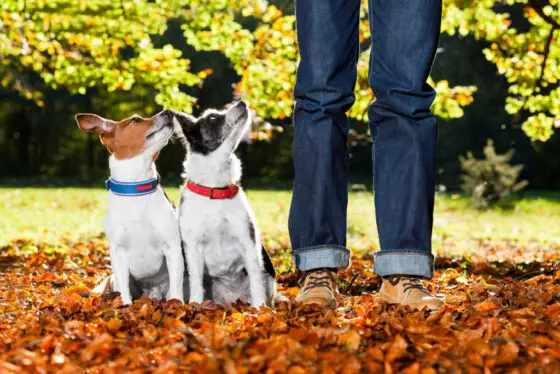Are you thinking of getting a puppy but unsure if you want one or two dogs?
There are lots of reasons that two dogs make sense, but there are also some pitfalls to owning two dogs.
One of those is dog training!
It’s much more difficult to train two dogs in one household at the same time.
Common Issues When Raising Two Dogs Together
Training issues aside, it’s just flat out harder than you think raising two puppies at once!
In fact, if you’re getting your puppies from a reputable breeder, they usually will not allow two puppies to leave their premises bound for the same home.
Here’s what you need to know about Littermate Syndrome (raising two puppies from the same litter, or even from different litters within 6 months of each other in age).
To give you some idea of what’s in store for you…
If you bring home two puppies, you will most likely have to deal with these types of issues:
- Half Dog Syndrome (also called Littermate Syndrome or Sibling Puppy Syndrome)
- Lack of time & energy
- Excessive stubbornness
- Stronger pack drive
- Scheduled play sessions
- Same sex dog issues
By the way, if you already have one dog and plan on bringing home another dog as a playmate, here’s how to properly introduce two dogs. (These tips work when introducing your dog to other dogs at the dog park as well.)
My Tips For Training Two Dogs
Okay, so you’re going to do it anyway, huh?
If you’re set on having two dogs, then that means you have to train two dogs. (I’ve done it myself, but it’s not easy.)
Here are my 3 best tips for training two dogs at once:
#1 – It is easiest to train two dogs, if you focus 100% of your attention on only one dog at a time.
First, practice teaching one dog how to do something. Then, practice teaching the other dog how to do it — as described in this video:
Although I don’t recommend it, you could also have two people (one with each dog) as you’re training two dogs the same command — as seen in this video:
TIP: Here’s a good example (proof that teaching two dogs the same thing at the same time doesn’t work): teaching two dogs how to walk on a leash without pulling.
#2 – It’s best if each dog is trained separately — with the other dog completely out of sight during the entire training session.
That way, you’re able to give your full attention to each dog individually. And you’re able to teach each dog at their own pace — as seen in this video:
Eventually (after they’ve mastered the basic dog training commands and they understand how to give you 100% of their attention during a training session), you will be able to practice new tricks and commands with them closer together — as seen in these next two videos:
TIP: Here’s a good example of dogs needing to be trained at their own pace at first: 3 reasons your dog doesn’t do what you want.
#3 – Always remember which dog is your dominant dog. (Usually it’s the older one, or the one that was living in the house before the other one.)
https://www.youtube.com/watch?v=DHPBLgqAZd4
It’s important to support the dominant dog at all times. Not that you don’t support the other dog — but the dominant dog gets first choice, first attention, first treats, etc. That’s just how the dog pack hierarchy works.
Your dominant dog will be less likely to create drama in the household and become jealous or aggressive with the second dog. (Here’s what to do if that happens.)
Later, after the first year or so, you can switch things up a bit and begin treating them more as equals (to you). Instinctively, they will still know who is the dominant dog, of the two.
TIP: Here are some tips for managing your dogs’ roles on a daily basis when you have two dogs and how to deal with conflict situations.
Like this post? Save it to read again later… or share with others on Pinterest!







